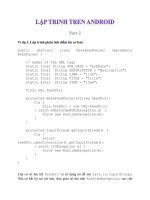Hướng tư duy lập trình đối tượng phần 2 docx
Bạn đang xem bản rút gọn của tài liệu. Xem và tải ngay bản đầy đủ của tài liệu tại đây (104.29 KB, 7 trang )
8
Chương 8: Tiếntớitư duy hướng đốitượng
// SimFun.h
inline double sum(double x1, double x2) { return x1 + x2; }
inline double gain(double K, double x) { return K * x; }
double limit(double Hi, double Lo, double x);
double integrate(double Ti, double Ts, double x);
// SimFun.cpp
double limit(double Hi, double Lo, double x) {
if (x > Hi) x = Hi;
if (x < Lo) x = Lo;
return x;
}
double integrate(double Ti, double Ts, double x) {
static double I = 0;
I += x*Ts/Ti;
return I;
}
9
Chương 8: Tiếntớitư duy hướng đốitượng
Vấn ₫ề?
Vẫnchưa ₫ủ tính linh hoạt, mềmdẻocầnthiết
Thay ₫ổi, mở rộng chương trình mô phỏng rấtkhó
khăn
Các khâu có trạng thái như khâu tích phân, khâu trễ
khó thựchiệnmộtcách"sạch sẽ" (trạng thái lưutrữ
dướidạng nào?)
Rấtkhópháttriển thành phầnmềmcóhỗ trợ₫ồhọa
kiểukéothả
10
Chương 8: Tiếntớitư duy hướng đốitượng
8.5 Tư duy dựa ₫ốitượng
// SimClass.h
class Sum {
public:
double operator()(double x1, double x2) {
return x1 + x2;
}
};
class Gain {
double K;
public:
Gain(double k = 1) : K(k) {}
double operator()(double x){ return K * x; }
};
class Limiter {
double Hi, Lo;
public:
Limiter(double h=10.0, double l= -10.0);
double operator()(double x);
};
11
Chương 8: Tiếntớitư duy hướng đốitượng
class Integrator {
double Ki, Ts;
double I;
public:
Integrator(double ti = 1.0, double ts = 0.5);
double operator()(double x);
};
class Delay {
double* bufPtr;
int bufSize;
double Td, Ts;
public:
Delay(double td = 0, double ts = 1);
Delay(const Delay&);
Delay& operator=(Delay&);
~Delay();
double operator()(double x);
private:
void createBuffer(int sz);
};
12
Chương 8: Tiếntớitư duy hướng đốitượng
#include <math.h>
#include "SimClass.h"
Limiter::Limiter(double h, double l) : Hi(h), Lo(l) {
if (Hi < Lo) Hi = Lo;
}
double Limiter::operator()(double x) {
if (x > Hi) x = Hi;
if (x < Lo) x = Lo;
return x;
}
Integrator::Integrator(double ti, double ts)
: Ts(1), Ki(1), I(0) {
if (ts > 0)
Ts = ts;
if (ti > 0)
Ki = ts/ti;
}
double Integrator::operator()(double x) {
I += x*Ki;
return I;
}
13
Chương 8: Tiếntớitư duy hướng đốitượng
Delay::Delay(double td, double ts) : Td(td), Ts(ts) {
if (Td < 0) Td = 0;
if (Ts < 0) Ts = 1;
createBuffer((int)ceil(Td/Ts));
}
double Delay::operator()(double x) {
if (bufSize > 0) {
double y = bufPtr[0];
for (int i=0; i < bufSize-1; ++i)
bufPtr[i] = bufPtr[i+1];
bufPtr[bufSize-1] = x;
return y;
}
return x;
}
void Delay::createBuffer(int sz) {
bufSize = sz;
bufPtr = new double[bufSize];
for (int i=0; i < bufSize; ++i)
bufPtr[i] = 0.0;
}
14
Chương 8: Tiếntớitư duy hướng đốitượng
// SimProg3.cpp
#include <iostream.h>
#include <conio.h>
#include <windows.h>
#include "SimClass.h"
void main() {
double Ts = 0.5;
Sum sum;
Gain gain(2.0);
Limiter limit(10,-10);
Integrator integrate(5,Ts);
Delay delay(1.0);
double r =1, y=0, e, u, ub;
cout << "u\ty";
while (!kbhit()) {
e = sum(r,-y); // Sum block
u = gain(e); // Static Gain
ub= limit(u); // Limiter
y = integrate(ub);// Integrator output
y = delay(y);
cout << '\n' << u << '\t' << y;
cout.flush();
Sleep(long(Ts*1000));
}
}









